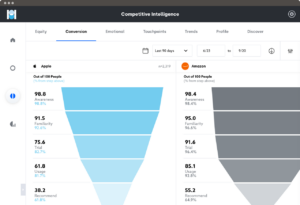Brief • 3 min Read

Annual inflation hovers above 8%, gas prices are high, grocery bills are high, utility bills are high, and Americans are cutting back on discretionary spending. Yet, the beauty industry appears immune to the country’s economic sickness. This is especially good news for beauty retailers, who suffered stunted sales throughout the COVID-19 pandemic as women eschewed makeup and high heels in favor of yoga pants and slippers.
Unlike many other retailers, Ulta’s sales (and stock price) have continued to climb. Ulta Beauty is the largest beauty retailer in the United States, and their recent growth is outpacing others in the beauty industry which suggests that they are gobbling up a larger share of the market.
Want to read more about retail trends? Check out our Retail, Grocery & Ecommerce: An Industry Snapshot report for insights and brand rankings.
Embracing the “lipstick index”
Even though Americans are guarding their pocketbooks, beauty sales remain high. Popularly known as the “lipstick index,” the beauty industry typically thrives during economic downturns and recessions. It is believed that consumers cut back on more expensive splurges (i.e., a dinner out, a new car, new clothing) during times of economic hardship, but consider beauty products an affordable luxury, and a crucial component of self-care.
According to The NPD Group, beauty is the only discretionary retail category that saw increased sales over the first half of 2022 (haircare +28%, makeup +20%, fragrance +15%, skincare +12%).
This trend aligns with Ulta’s growth. Throughout 2022, the retailer has experienced increased sales across all product categories. In Q2, their sales grew 16.8% (hitting $2.3 billion), leading them to raise their yearly forecast to $9.75 billion, a billion more than their 2021 sales ($8.63 billion). Ulta’s stock price reached an all time high in September 2022 at $446.14/share.
Strengthening in-store and online touchpoints
Last year, Ulta Beauty partnered with beloved retail giant Target to open hundreds of Ulta Beauty shops inside of established Target stores. This year, they plan to expand this store-within-a-store model with an additional 250. Eventually, Ulta expects to have shops within approximately 800 Target locations (about 40% of Target stores). This approach makes it easier for Ulta enthusiasts to quickly pick-up their favorite products, and exposes many new consumers to the Ulta brand.
In addition to expanding their brick-and-morter footprint, Ulta used the COVID pandemic as an opportunity to refine their online and in-app options. Ulta has established a strong online presence, and even provides on-app augmented reality (GLAMLab) for shoppers to virtually try on makeup options before purchase.
Ulta’s customer loyalty program, Ultamate Rewards has also gone a long way in helping the retailer thrive. This year, the program boasted 38 million members, who made up an astonishing 95% of Ulta sales. By allowing customers to earn points on purchases that can later be turned into dollars off future purchases, Ulta’s reward program has helped them establish a loyal consumer base. This program has also allowed the beauty retailer to gather key sales data on their consumers so they know what products resonate with their shoppers.
Ulta’s growth extends beyond its sale numbers
In addition to sales growth, QuestBrand data shows that consumer sentiment towards Ulta has also been on the rise.
Ulta Beauty ranked fourth in the top growth retail brands from Q2 to Q3 (based on brand equity). Brand equity measures the overall value consumers see in a brand at a certain point in time. It is an average of four key components: consumer familiarity with a brand, perceived brand quality, purchase consideration, and perceived brand momentum.
Consumers in particular reported higher perceived quality (+4.2) and purchase consideration (+4.9), strengthening the idea that Ulta could be enticing consumers away from their competitors and cornering a greater share of the beauty market.
Ulta's increased popularity makes sense. A highly diverse beauty store, they carry more than 25,000 products, 600 brands, and an array of both prestige and discount cosmetics, making the brand approachable to consumers of all budget levels.
If the economy continues to decline, we will have to see how it influences consumers' beauty purchases. Will consumers begin to favor more affordable over prestige brands? Or will consumers continue to treat themselves to "affordable luxuries" as a form of self-care during difficult economic times?
Subscribe for more Insights
Subscribe to our newsletter for the latest trends in business, politics, culture, and more.

Related Content








